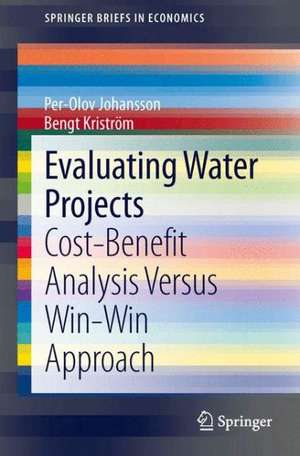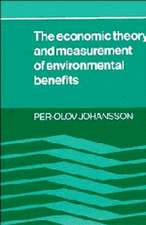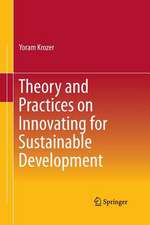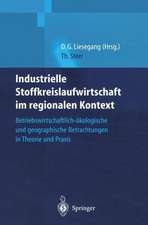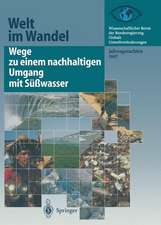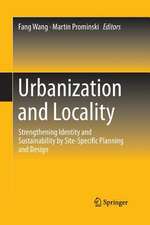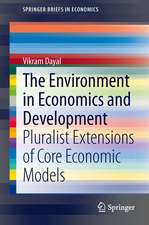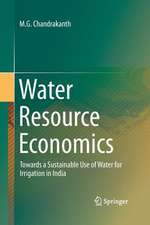Evaluating Water Projects: Cost-Benefit Analysis Versus Win-Win Approach: SpringerBriefs in Economics
Autor Per-Olov Johansson, Bengt Kriströmen Limba Engleză Paperback – 18 apr 2013
The first is a cost-benefit analysis, examining the case of re-regulating a Swedish hydropower plant in which water is diverted from electricity generation to the downstream dryway. The proposed scenario generates environmental and other benefits, but comes at a cost in terms of lost electricity.
The second study introduces an approach very different from the one used in conventional cost-benefit analysis, and provides a set of measures designed so that most, if not all, affected parties will be better off. Thus, in contrast to a conventional cost-benefit analysis, which draws on hypothetical compensation measures, the new approach envisages actual compensation.
Comparing two different theoretical frameworks on the basis of a real-world case, this study can be seen as a manual that can be used to evaluate reasonably small re-regulation of rivers.
Din seria SpringerBriefs in Economics
-
 Preț: 444.35 lei
Preț: 444.35 lei -
 Preț: 264.79 lei
Preț: 264.79 lei - 15%
 Preț: 462.51 lei
Preț: 462.51 lei -
 Preț: 47.33 lei
Preț: 47.33 lei -
 Preț: 353.14 lei
Preț: 353.14 lei -
 Preț: 273.32 lei
Preț: 273.32 lei -
 Preț: 376.04 lei
Preț: 376.04 lei -
 Preț: 379.09 lei
Preț: 379.09 lei -
 Preț: 380.07 lei
Preț: 380.07 lei -
 Preț: 377.35 lei
Preț: 377.35 lei -
 Preț: 379.09 lei
Preț: 379.09 lei -
 Preț: 376.59 lei
Preț: 376.59 lei -
 Preț: 408.27 lei
Preț: 408.27 lei -
 Preț: 379.09 lei
Preț: 379.09 lei -
 Preț: 383.27 lei
Preț: 383.27 lei -
 Preț: 378.54 lei
Preț: 378.54 lei -
 Preț: 377.95 lei
Preț: 377.95 lei -
 Preț: 340.23 lei
Preț: 340.23 lei -
 Preț: 380.25 lei
Preț: 380.25 lei -
 Preț: 378.12 lei
Preț: 378.12 lei -
 Preț: 376.04 lei
Preț: 376.04 lei -
 Preț: 376.04 lei
Preț: 376.04 lei -
 Preț: 379.68 lei
Preț: 379.68 lei -
 Preț: 381.00 lei
Preț: 381.00 lei -
 Preț: 375.23 lei
Preț: 375.23 lei -
 Preț: 376.80 lei
Preț: 376.80 lei -
 Preț: 378.54 lei
Preț: 378.54 lei -
 Preț: 377.57 lei
Preț: 377.57 lei -
 Preț: 376.04 lei
Preț: 376.04 lei -
 Preț: 378.92 lei
Preț: 378.92 lei -
 Preț: 375.62 lei
Preț: 375.62 lei -
 Preț: 379.09 lei
Preț: 379.09 lei -
 Preț: 353.67 lei
Preț: 353.67 lei -
 Preț: 342.14 lei
Preț: 342.14 lei -
 Preț: 375.45 lei
Preț: 375.45 lei -
 Preț: 379.09 lei
Preț: 379.09 lei -
 Preț: 377.35 lei
Preț: 377.35 lei -
 Preț: 344.86 lei
Preț: 344.86 lei -
 Preț: 377.35 lei
Preț: 377.35 lei -
 Preț: 345.89 lei
Preț: 345.89 lei -
 Preț: 377.57 lei
Preț: 377.57 lei -
 Preț: 343.83 lei
Preț: 343.83 lei -
 Preț: 378.12 lei
Preț: 378.12 lei -
 Preț: 345.06 lei
Preț: 345.06 lei -
 Preț: 379.48 lei
Preț: 379.48 lei -
 Preț: 379.48 lei
Preț: 379.48 lei -
 Preț: 380.07 lei
Preț: 380.07 lei -
 Preț: 445.33 lei
Preț: 445.33 lei -
 Preț: 378.54 lei
Preț: 378.54 lei
Preț: 375.45 lei
Nou
Puncte Express: 563
Preț estimativ în valută:
71.84€ • 75.01$ • 59.46£
71.84€ • 75.01$ • 59.46£
Carte tipărită la comandă
Livrare economică 04-18 aprilie
Preluare comenzi: 021 569.72.76
Specificații
ISBN-13: 9783642367892
ISBN-10: 3642367895
Pagini: 80
Ilustrații: VIII, 67 p. 11 illus., 2 illus. in color.
Dimensiuni: 155 x 235 x 12 mm
Greutate: 0.12 kg
Ediția:2013
Editura: Springer Berlin, Heidelberg
Colecția Springer
Seria SpringerBriefs in Economics
Locul publicării:Berlin, Heidelberg, Germany
ISBN-10: 3642367895
Pagini: 80
Ilustrații: VIII, 67 p. 11 illus., 2 illus. in color.
Dimensiuni: 155 x 235 x 12 mm
Greutate: 0.12 kg
Ediția:2013
Editura: Springer Berlin, Heidelberg
Colecția Springer
Seria SpringerBriefs in Economics
Locul publicării:Berlin, Heidelberg, Germany
Public țintă
ResearchCuprins
Preface.- 1 Introduction.- 2 The Dönje Hydropower Scenario.- 3 The -2,+1 Hydropower Scenario.- 4 A Brief Comparison of the Approaches and an Outlook.- References.- Appendices.- Index.
Notă biografică
Per-Olov Johansson is Professor emeritus in economics at the Stockholm School of Economics. He has held a professorship (II) in health economics at the department of Economics at the University of Oslo and a professorship in resource and environmental economics at the Swedish University of Agricultural Sciences, Umeå. He has published more than 10 books internationally and more than 100 journal articles and book chapters.
Bengt Kriström is Professor of Resource Economics (SLU-Umeå) and Research Director, CERE, Sweden. His research is widely cited (top 1000 economists according to a 2002 compilation) and includes 50+ papers and 10 books. He has been a consultant to several international organizations, including the OECD and, at numerous occasions, the Swedish Government. He has organized the Ulvön International Conference on Environmental Economics since 1993.
Bengt Kriström is Professor of Resource Economics (SLU-Umeå) and Research Director, CERE, Sweden. His research is widely cited (top 1000 economists according to a 2002 compilation) and includes 50+ papers and 10 books. He has been a consultant to several international organizations, including the OECD and, at numerous occasions, the Swedish Government. He has organized the Ulvön International Conference on Environmental Economics since 1993.
Textul de pe ultima copertă
Should more water be diverted to or from electricity generation? This timely question is addressed in this short volume. Two different approaches are introduced and compared:
The first is a cost-benefit analysis, examining the case of re-regulating a Swedish hydropower plant in which water is diverted from electricity generation to the downstream dryway. The proposed scenario generates environmental and other benefits, but comes at a cost in terms of lost electricity.
The second study introduces an approach very different from the one used in conventional cost-benefit analysis, and provides a set of measures designed so that most, if not all, affected parties will be better off. Thus, in contrast to a conventional cost-benefit analysis, which draws on hypothetical compensation measures, the new approach envisages actual compensation.
Comparing two different theoretical frameworks on the basis of a real-world case, this study can be seen as a manual that can be used to evaluate reasonably small re-regulation of rivers.
The first is a cost-benefit analysis, examining the case of re-regulating a Swedish hydropower plant in which water is diverted from electricity generation to the downstream dryway. The proposed scenario generates environmental and other benefits, but comes at a cost in terms of lost electricity.
The second study introduces an approach very different from the one used in conventional cost-benefit analysis, and provides a set of measures designed so that most, if not all, affected parties will be better off. Thus, in contrast to a conventional cost-benefit analysis, which draws on hypothetical compensation measures, the new approach envisages actual compensation.
Comparing two different theoretical frameworks on the basis of a real-world case, this study can be seen as a manual that can be used to evaluate reasonably small re-regulation of rivers.
Caracteristici
Compares two approaches to handling natural resource conflicts A brand-new approach to empirical assessment of re-regulations Case of a hydropower plant in Sweden Includes supplementary material: sn.pub/extras
